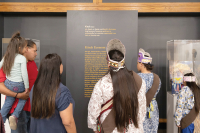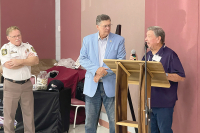Outsider Art: Franklin’s Bill Lea is a nationally recognized nature photographer
It started out simply enough.
Fresh out of college on his new job in Vicksburg, Miss., on the banks of the mighty, muddy Mississippi, Bill Lea decided to try a new hobby. He laid down his fishing pole and picked up his camera.
“I had always fished, but the waters around Vicksburg were just too muddy,” Lea explained as the reason he decided, almost on a whim, to take up a new outdoor pastime that day.
Some 36 years later, Lea, who lives in Franklin, is a nationally recognized nature photographer, author and wildlife lecturer. More than 6,000 of his images have been featured in calendars, books, advertisements and other publications, including several works on the Great Smoky Mountains National Park, National Geographic books, Nature Conservancy, Outdoor Life and Field and Stream magazines.
During his nearly four decades behind the lens, Lea has spent countless hours watching and observing wildlife.
“I learned about animals as I photographed them. And as I photographed them, I kind of formed a bond with each one,” Lea said. “When you spend hours in the woods with an animal, you get to know them individually.”
Lea studied forestry in college and got a job with the forest service shortly after graduating. He moved to the mountains of WNC in 1983 to work for the Pisgah National Forest and then later the Nantahala National Forest.
Lea’s love of photography and wildlife, especially black bears, grew as he encountered wild creatures on his job and during his outdoor photo sessions. Lea learned through his interaction with wild creatures, that each animal, even those of the same species, had its own distinctive features and personalities and that seemed especially true of the black bears.
“That’s what I really love about photographing animals,” Lea said. “For instance, take a bear. Look in their eyes. You can tell they’re thinking about something. They look at you with intelligence. Bears have personalities. Some are playful, some aren’t. And if you study them, you’ll see there is a lot of similarities between them and dogs.”
Lea began to specialize in studying and photographing black bears in the mid-1990s and about 10 years later, he took an early retirement from the forest service to devote full time to his hobby-turned-career.
An eye-opening bear encounter produced some of his favorite bear photographs and impressed Lea with the black bear‘s ingenuity and intelligence. As he watched through his camera lens, a female bear trying to cross a swift-moving mountain stream laid down a log and walked across it, then repositioned the log and walked back across.
The budding photographer was astonished by the bear’s purposeful action. He still speaks with unabashed appreciation for what he saw the bear do many years ago. “She was using a tool. That indicates the highest form of intelligence,” Lea said.
Lea now dedicates much of his life to “speaking for the bears.”
“They have given me so much pleasure in my life. I have so much gratitude. It’s a way to pay back to them for what they have brought into my life and to rectify an injustice that has been done to them,” Lea explained.
Lea is co-founder of the American Bear Association, a non-profit foundation that operates a wildlife sanctuary in Minnesota.
Recently, Lea is lending his expertise to the new Bear Smart Initiative, an effort by the Jackson-Macon Conservation Alliance to educate residents and visitors how to safely co-exist with bears.
“As more and more people move into bear habitat, there will be more and more human/bear encounters,” Lea said. “Bears have nowhere else they can move, so we humans need to learn to co-exist peacefully with our black bear neighbors.”
A quiet-spoken, reserved individual who doesn’t relish public speaking or the limelight, Lea has become a frequent lecturer to civic groups. His entertaining, informational presentations are accompanied by slides of his outstanding bear photos. Lea uses these talks, his writings and photos, to teach people about bears because he feels he must give a voice to the bears since “they cannot speak for themselves.”
“So often, bears end up being killed because of what people think they are going to do, as opposed to what they are going to do. They are very misunderstood by most people because of negative human attitudes, some created by the media and taxidermists poses. They are not ferocious, unpredictable animals as they are commonly portrayed,” Lea emphasized. “They are not cuddly Teddy bears, but black bears are not grizzlies either. They are shy and tolerant and they are predictable.”
Bears are also “very intelligent, and very, very curious” with extremely good memories, according to Lea. All those attributes need to be considered when living or camping in bear country. Lea also warns that feeding bears is not helpful to them. It may be fun for humans at first and enable them to enjoy seeing bears up close, but in the end, teaching bears to eat human food is a bad thing for both humans and bears.
“By closely watching the bears in the wild and at the Minnesota sanctuary in particular, it has taught us why you should never feed bears,” Lea said. “There’s always going to be someone who has intolerant feelings toward the bears. And by feeding them, you are basically setting them up for death.”
Lea hopes his work with the J-MCA Bear Smart Initiative and his other efforts will eventually pay off in a better relationship between humans and bears that will help keep both safe.
“Our best avenue is to teach people about bears…and once people understand them, they will be greeted with respect. With education, we can make a difference, changing attitudes, one person at a time.”
Karen Spencer is a free-lance writer who divides her time between homes in Cashiers and the Florida panhandle. A descendant of early Smoky Mountain pioneers, her life-long interest and fascination with wild black bears began as a child on excursions with her “Tennessee cousins” in the mountains of Eastern Tennessee and Western North Carolina. Her journalism career has included jobs at both large and small newspapers, as well as specialty publications, in several states.
By Karen Spencer • Contributing writer
See Bill Lea’s work
Bill Lea has authored two books, Great Smoky Mountains Wildlife Portfolio, and, Cades Cove: Window to a Secret World.
An artist’s rendition of one of Lea’s bear images is featured on the Tennessee wildlife license plate, and he contributed photos and information for a the recently-published book, Frequently Asked Questions About Smoky Mountain Black Bears, written to inform park visitors about how to enjoy the park and its black bear inhabitants by the Great Smoky Mountain Association.





